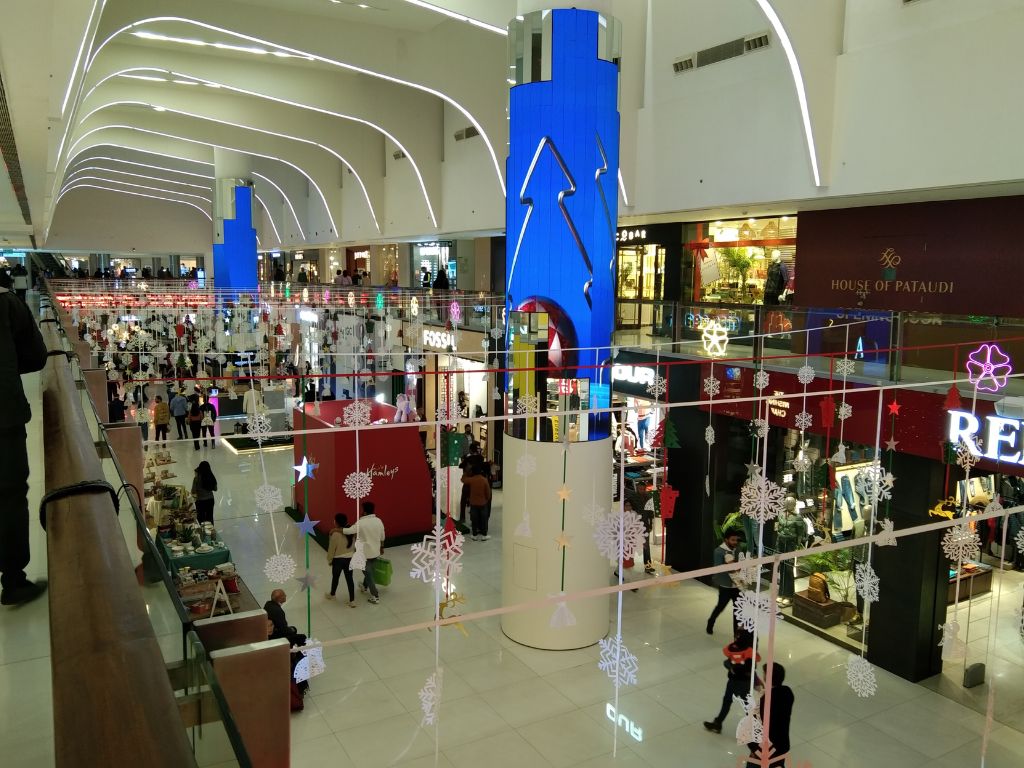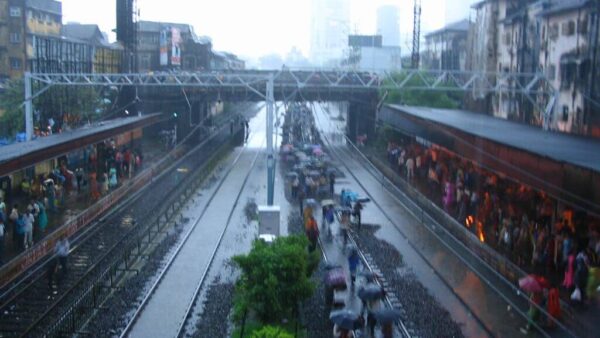Mumbai’s iconic Crawford Market is packed with a super-dense crowd every day in the days running up to Diwali. At one of many dry fruit stalls here, managers Raheem and Paresh barely croak out their words after speaking to customers – often at the top of their voices to be heard over the din – for two weeks without a break. They pass around lozenges to soothe their throats but those barely help. This is dhanda time, so they plough on.
In New Delhi’s Lajpat Central market, Umesh Kumar Shah, who usually deals in utensils, took to selling colourful rangoli powder among other festive commodities. He finds festive-related business more rewarding at this time of the year. However, the offtake is lower this year, he says, perhaps because “people prefer online shopping”. In Indore, Nannu Rathore landed a temporary second job, during Diwali, as a demonstrator in a clothing shop to meet the rush. “The shop remains open till as late as midnight, customers walk in late,” she says.
Come Diwali, or any festival, there is an inevitable surge in people’s buying behaviour as well as the number and scale of items flooding markets in every city. There is now almost an irrefutable push for consumers to spend as old cultural traditions are commercialised or newer ones established around buying behaviour. To cite only two examples, Valentine’s Day, a distinctly urban celebration, is now widely followed in cities with a major push from jewellery, fashion and wellness providers measuring people’s romance in the products they buy that day, or the profusion of designer wear and styling products on the occasion of Karva Chauth or Eid-e-Milad or Christmas.
From colourful lights, festive decorations (often in unsustainable materials like thermocol), perishables like food and flowers, white goods like air-conditioners, property, vehicles and more – festivals have come to mean buying, consuming, gifting and more ordering especially for India’s urban middle and upper classes with disposable incomes. In every city across India, sellers are a part of this glittering consumptive tapestry at festival time – from small vendors finding their best spots on arterial roads and making a few hundred more to the pan-Indian mega retail chains which announce hefty festival discounts. As Diwali rolled in, registrations of cars and two-wheelers in Mumbai increased by a healthy 17 percent and 12 percent respectively over last year. What would this do to the already-congested traffic situation? Well, few think of practicality and sustainability on Diwali anyway.

Photo: Mithil Byri/ Creative Commons
How big is the festival economy
Whether Diwali or Eid or Christmas or any regional and community festival, there is an undeniable economy around each. The sheer size of the Hindu population would make Hindu festivals bring in the largest number of consumers and higher footfalls, but there’s no denying that most festivals, as celebrated in cities in contemporary ways, increase the revenue flow and boost the urban economy.
Ganeshotsav, the ten-day public celebration of the elephant-headed god which Maharashtra and Mumbai are famous for, generates revenues close to Rs 50,000 crore.[1] In 2022, the Confederation of All India Traders (CAIT) estimated that the Diwali business would surpass Rs 1.5 lakh crore in the country[2]
September and October, months that saw Ganeshotsav and Navratri, also saw a surge in people spending money. In October 2023, the UPI-processed transactions totalled Rs 16.46 lakh crore, an increase of more than 40 percent from the same time last year. According to data from the Reserve Bank of India, credit card payments in India jumped 16 percent from last September.[3]
Additionally, the Goods and Services Tax (GST), a reliable marker of the economy, rose by 10 percent from September last year to Rs 1.6 lakh crore this year.[4] There are other pointers too. The electricity demand this September saw an all-time high of 240 gigawatts which points to an increased activity in industrial and manufacturing sectors.[5] To meet the demand for electricity and ensure a reduction in the use of generators, the Delhi government decided to provide tatkal connections to event organisers this October.[6]
This Diwali, the Bombay Stock Exchange, which marked the end of Vikram Samvat year 2079 and started the next with Mahurat trading, reportedly had a record market capitalisation of Rs 320 lakh crore – a robust 16 percent rise in investors’ wealth during the year. All over India, mainly driven by urban centres, Dhanteras day saw a nearly 21 percent increase in car and SUV sales by major automobile sellers, sales of gold and jewellery as well as electronics – especially mobile phones – surged.[7]
This year also saw a rise in the trend of online shopping, as per industry reports. According to InMobi’s report on the Marketers Guide to India’s Festive Season, 84 percent of Indian festive shoppers had increased their budgets and 54 percent were looking to shop online or in the hybrid mode. The flip side is that fewer people buy from small shops selling puja items, earthen lamps and rangoli powder, the kind that Makarand Bhagat has had for decades in Mumbai’s crowded Dadar market.
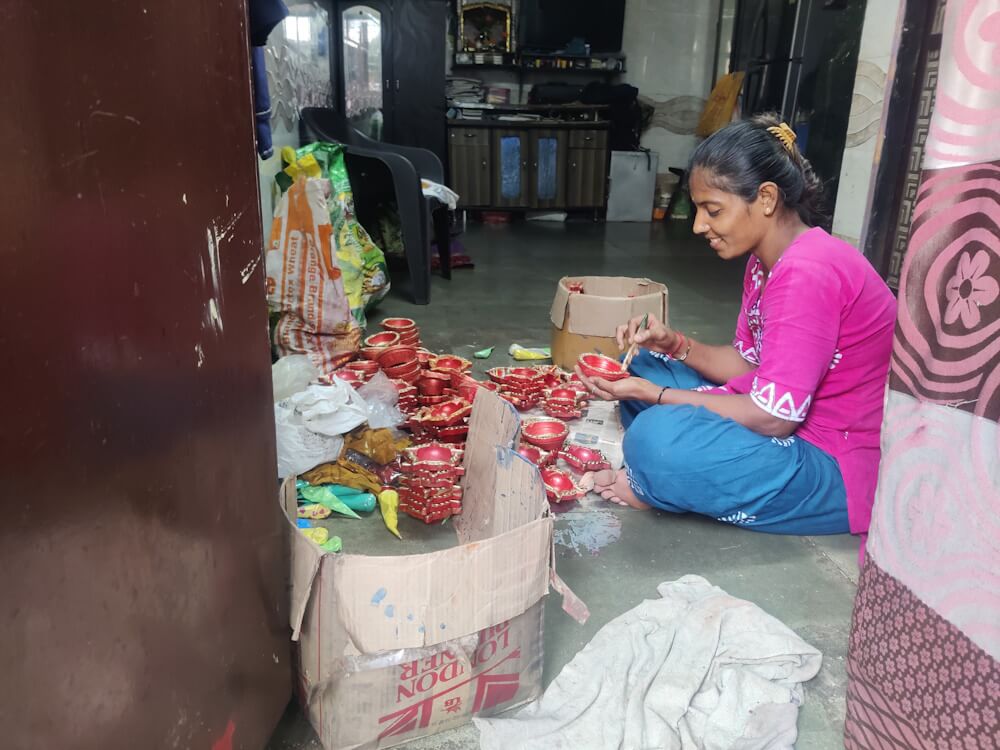
Photo: Jashvitha Dhagey
Women and festival
There is a gender aspect to festivals in cities – women craft and produce or put finishing touches on the smaller items sold routinely in neighbourhood offline markets, women bear the burden of juggling their work with the many domestic tasks required for the family to celebrate together, women often end up cooking special meals or snacks into late hours.
In the Kumbharwada, or potters’ village, in Mumbai’s Dharavi, women prepare for the festival of lights all the year round, decorating and finishing clay diyas within and outside their tiny homes. The families here, all involved in pottery and clay work, earn just enough to last the year. The median level is like Meera Arvind Gohil’s income, which given the volume of diyas, fetches her between Rs 1.5 to 3 lakh a year. Daksha Nitesh Waghela, 36, juggles between domestic chores and decorating diyas. She and others in her neighbourhood have seen a drop in the orders since the pandemic. Most men in Kumbharwada have day jobs and only lend a hand in the run-up to Diwali like Lavaji Jiva, 55, a mason.
Noted economist Dr Vibhuti Patel points out, “Women have limited access to markets. The men here assist in the outdoor work of selling.” Like Vinod Ramjiwala, a carpenter helping his wife and daughter-in-law in lamp-making, men believe “design aur decoration toh aurat ka kaam hai (design and decoration is a woman’s job).” The mobility of women in business is limited too; men go out with carts, women mostly carry headloads.
Dr Ritu Dewan, former head of department for Economics, University of Mumbai, says, “When products leave the house, they are sold or transported by a man. That gender divide is reinforced.” She laments that the definition of a worker in the soon-to-be implemented Indian Labour Code only recognises people employed in an enterprise, not a household which “denies household workers and domestic workers the economic benefits of loans and schemes”.
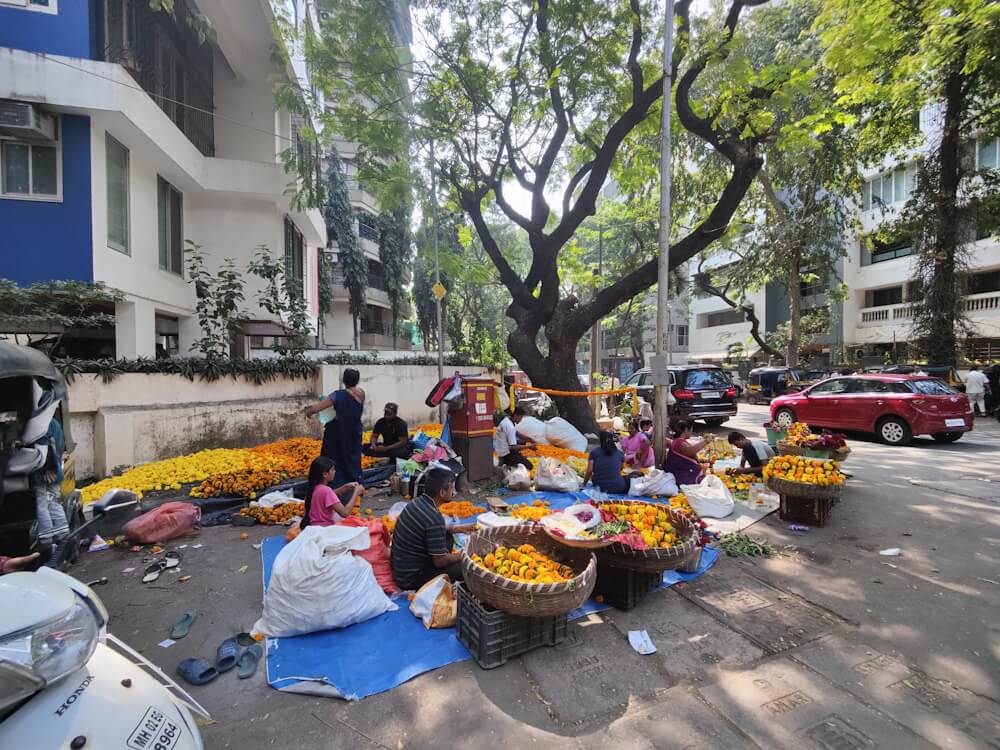
Photo: Shivani Dave
Artisanship, headloads and big buys
Festivals like Durga Pujo bring recognition and money for traditional artists. Suryasarathi Bhattacharya, a journalist based in Delhi who visited Kolkata during Pujo, says that “pandals hire original Pattachitra artists to make these paintings, incurring an expense in lakhs, apart from the travel, food and stay expenses of the artists”. Some used articles are auctioned later.
Artists are in demand across many festivals, so are the pathi kamgars or hamalis (head loaders) who believe it is the season to make a few extra rupees. Shops hire them, so do customers. While the shopkeepers pay them Rs 20 per load, the shoppers pay them Rs 100 to cart a large volume of goods to a destination. Clothes are among the top-selling items before any festival or the wedding season.
Vikram Purohit, 26, works at a wholesale shop for children’s clothes in Dadar market, and has seen orders of Rs 4 to 5 lakh a day during Diwali in the last five years. Vishnu Verma, owner of a saree shop in Delhi’s Lajpat Nagar, says he sells the highest number of lehengas in the festive season – almost twice his regular number. Syed Rashid, 30, who sells bangles in Mumbai’s Dadar, says that his business picks up during Ramzan Eid, Diwali and Navratri. Umesh Kanhaiyalal Gupta, 46, runs an all-season stall at Dadar market with torans, umbrellas during the monsoon, rakhis during Raksha Bandhan, earthen lamps and rangoli powder during Diwali, purses and handbags in December-January. The rangoli powder is his most-sold commodity; at Rs 10 a packet, he relies on it.
At the other end of the spectrum, luxury retail brands, including Swiss chocolatier Laderach and fashion label Balenciaga SA, made a beeline to set up shop ahead of the festive season, entering into partnerships with top-of-the-line Indian luxury brands or leasing space in exclusive malls.[8] DLF, a frontline luxury mall in NOIDA saw a jaw-dropping 50 percent growth in demand for branded watches and jewellery, among other luxury goods, over last year.[9]
This does not sit well in a country where, with days left for Diwali, the government announced an extension of the free or subsidised basics to 800 million. The luxury market, analysts explain, is immune to inflation and rising costs of living given that the spenders are high net worth or ultra-high net worth individuals with large disposable incomes.
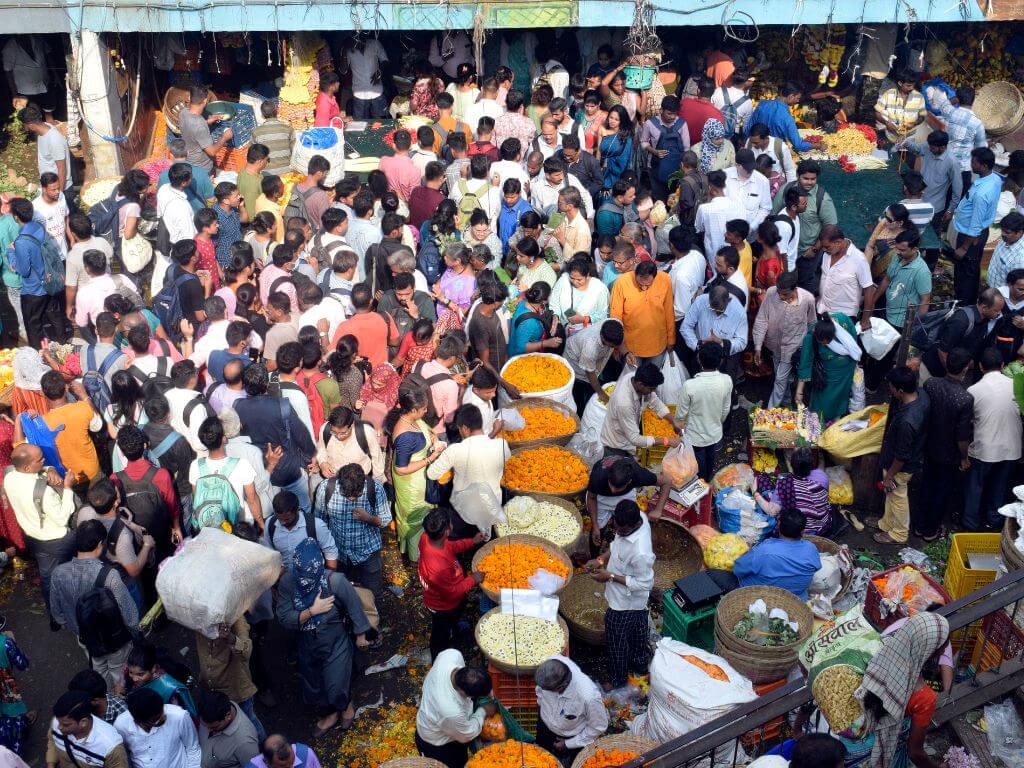
Photo: Imtiyaz Shaikh
Demand for workers
The rising tide lifts mostly the large boats; the majority of people fall back on doing the small stuff. Gig services offer a way out for most self-employed or migrants.
Afsan Alam, a former farmer, in his 40s, migrated to Mumbai to do his thing but ended up working for the Morde family who own two dry fruits stores and a fruit shop. Packing an order of fruit baskets that cost Rs 1,500 to Rs 3,000 each to be gifted to politicians, he says, “We get so many orders that we employ extra workers to pack the hampers.” The workers make a few extra thousands to celebrate their Diwali.
The demand for gig workers, delivery executives and home service providers in cities also shoots up during festivals. Vahan, an AI-powered platform linking blue-collar workers and jobs, reportedly placed over four lakh delivery riders across 200 cities in India for brand partners like Amazon, Flipkart, Rapido, Swiggy, Uber, Zepto, and Zomato.[10] The demand for temporary jobs – as salespersons, demonstrators, packers, digital marketers, partner-seller services – also rises. This year’s festive hiring was anticipated, in a study, to see a 25 percent increase in gig jobs compared to last year’s season.[11]
But what happens to these jobs once the festive season ends? The Centre for Monitoring Indian Economy found that India’s unemployment rose to a two- year high of 10.05 percent in October 2023 from 7.09 percent in September. Urban joblessness rose to 8.44 percent. According to the think tank, 10 million people entered the workforce but urban India performed better due to an expansion in manufacturing and consumption.[12]
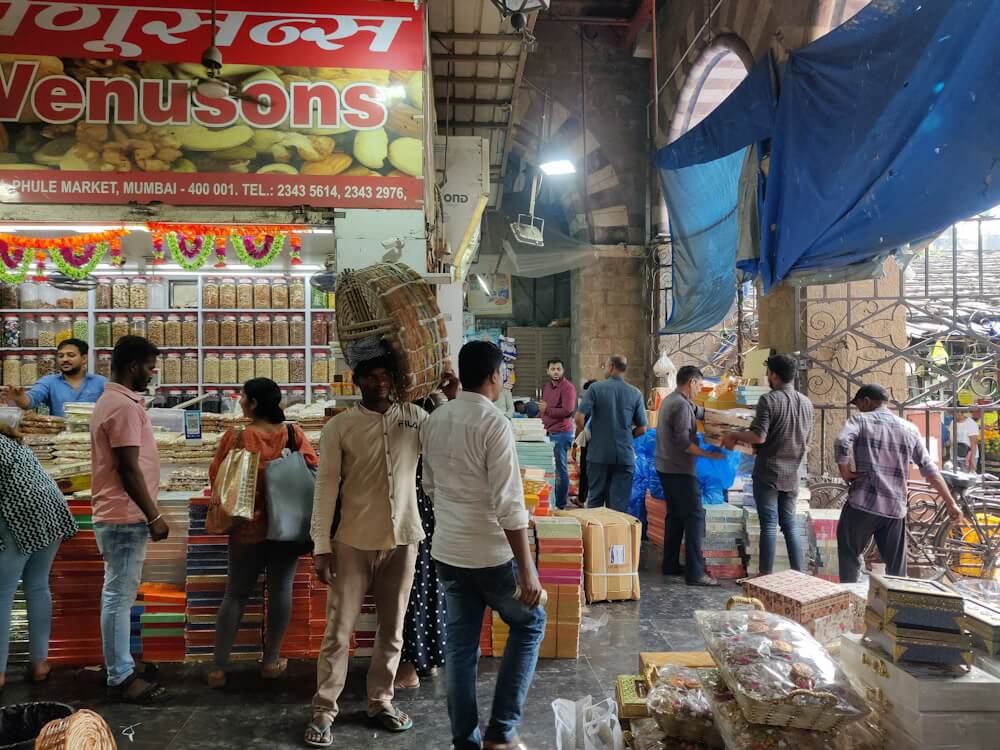
Photo: Jashvitha Dhagey
Consumerism at its peak during festivals, driven by large cities and tier 2 towns where most of the upper-middle and upper classes – the consumptive classes – live. Most surveys show that the number of Indians earning over Rs 5 lakh per annum, the line where middle class begins, has multiplied several times over the past decade or 15 years; it was 18 million in 2020-21, based on Income Tax data.[13]
At the other end of this glittering consumptive class are people who rely on government handouts, small earnings and gig jobs to tide over the festival season. There were 45.2 million households – nearly 220 million people – with household income of less than Rs 1.25 lakh per annum or just about Rs 10,000 a month; there has been 7.3 percent increase in the number of poor in cities every year between since 2015, according to this report.[14]
Going forward, the questions that arise about festivals in cities demand attention – with people turning to hybrid buying, what happens to the tiny profits earned by small-time vendors of festival items; will the cheaper and Chinese-origin decorations widely available lead to a shrinking of India’s artisans and craftspeople who wait for festivals to make their annual income; as traditional commodities become artisanal and expensive, how will their producers and sellers cope; how can the chasm between the top few and bottom many be bridged because shouldn’t everyone celebrate festivals?
The current political climate is not helping, says Dr Ritu Dewan, “Minority communities are not allowed to participate in this economy especially if it’s religious-oriented, there’s also the majoritarian fiscal policy with no GST on sindoor, rudrakshmala, mangalsutra and bindis which means a certain community benefits…
People need to be sensitised to celebrate festivals in a socially accountable way with concern for the natural environment and vulnerable population too.” That’s easier said than done.
With inputs from Suditi Gupta (Indore) and Sejal Patel (Delhi).
Jashvitha Dhagey is a multimedia journalist and researcher. A recipient of the Laadli Media Award 2023, she observes and chronicles the multiple interactions between people, between people and power, and society and media. She developed a deep interest in the way cities function, watching Mumbai at work. She holds a post-graduate diploma in Social Communications Media from Sophia Polytechnic.
Cover photo: Luxury retail brands make a beeline to lease space in exclusive malls ahead of the festive season by Biswarup Ganguly/ Creative Commons

